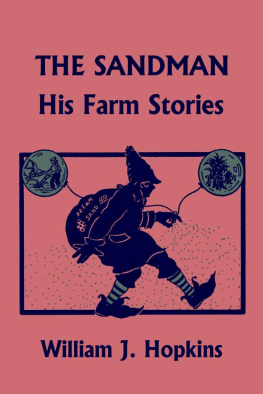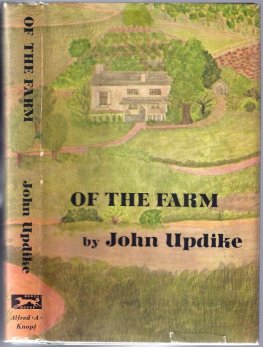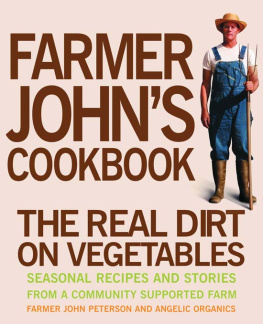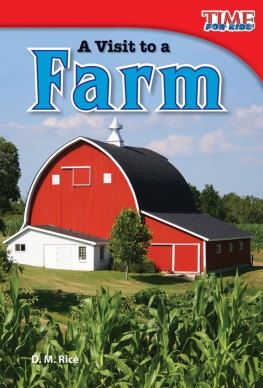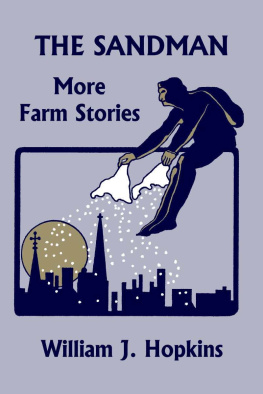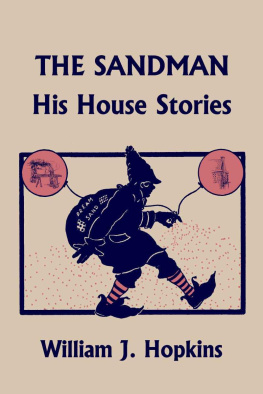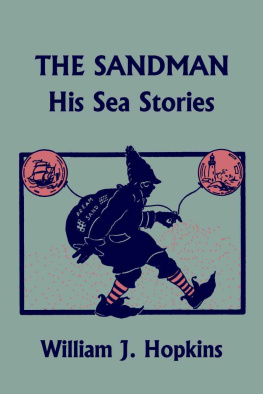The Sandman: His Farm Stories
by
William J. Hopkins
Yesterday's Classics
Chapel Hill, North Carolina
Cover and Arrangement 2010 Yesterday's Classics, LLC
All rights reserved. No part of this book may be reproduced or retransmitted in any form or by any means without the written permission of the publisher.
This edition, first published in 2010 by Yesterday's Classics, an imprint of Yesterday's Classics, LLC, is an unabridged republication of the work originally published by The Page Company in 1902. This title is available in a print edition (ISBN 978-1-59915-300-1).
Yesterday's Classics, LLC
PO Box 3418
Chapel Hill, NC 27515
Yesterday's Classics
Yesterday's Classics republishes classic books for children from the golden age of children's literature, the era from 1880 to 1920. Many of our titles are offered in high-quality paperback editions, with text cast in modern easy-to-read type for today's readers. The illustrations from the original volumes are included except in those few cases where the quality of the original images is too low to make their reproduction feasible. Unless specified otherwise, color illustrations in the original volumes are rendered in black and white in our print editions.
Introduction
When little John and little Charles lived on a farm, everything they did took lots of time and lots of work. But nobody seemed to mind. They had fun along with their work.
When Aunt Deborah wanted corn meal to make Johnny-cake, Uncle John first had to haul the corn to the mill in an oxcart. Then he hauled it slowly home again. But even this couldn't be done until after he had raised the corn in the field and then harvested it.
Aunt Deborah's kitchen was not like any that we have today. Instead of a stove she and Aunt Phyllis cooked over a fireplace. And they didn't dare to let the fire go out, for there were no matches in those days! If the fire did go out, how do you suppose they started it again?
When little John and little Charles wanted a day of fun, they went with Uncle Solomon in his boat on the big pond. He rowed them to a place where the water was not very deep. After the boys had taken off their clothes, Uncle Solomon lifted each boy and threw him into the water.
It was fun to go into the maple-sugar woods in the early spring, when the maple sap began to run. Uncle John always made enough syrup and sugar in the spring to last all year, for there wasn't a store near by where he could buy more.
Little John thought that the most fun of all was to ride into town with his father to take the farm produce to market. This day came at the end of summer, when all the ripe fruits and vegetables and other foods had been gathered. The trip to town and back took all day.
You can see that little John and little Charles had a very different life from yours. That is why it is fun to read about it.
Preface
Whatever may be thought of these stories by older people, they have served, with some others, to induce a certain little boy to go to sleep, and for nearly three years my one listener has heard them repeated many times, and his interest has never flagged. As the farm stories slowly grew in number, they entirely displaced the other stories, and that farm has become as real in the mind of my audience as it was in fact when little John was driving the cows, or planting the corn, seventy-five years ago.
The detail, which may seem excessive to an older critic, was in every case, until I had learned to put it in at the start, the result of a searching cross-examination. If the bars were not put up again, the cows might get out; and if the oxen did not pass, on their return, all the familiar objects, how did they get back to the barn? It is the young critics that I hope to please, those whose years count no more than six. If they like these farm stories half as well as my own young critic likes them, I shall be satisfied.
Contents
CHAPTER I
The Oxen Story
O NCE upon a time there was a farm-house, and it was painted white and had green blinds, and it stood not far from the road. And in the fence was a wide gate to let the wagons through to the barn. And the wagons, going through, had made a track that led up past the kitchen door and past the shed and past the barn and past the orchard to the wheat-field.

Not far from the kitchen door was a well, with a bucket tied by a rope to the end of a great long pole. And when they wanted water, they let the bucket down into the well and pulled it up full of water. They used this water to drink, and to wash faces and hands, and to wash the dishes; but it wasn't good to wash clothes, because it wouldn't make good soap-suds. To get water to wash the clothes, they had a great enormous hogshead at the corner of the house. And when it rained, the rain fell on the roof, and ran down the roof to the gutter, and ran down the gutter to the spout, and ran down the spout to the hogshead. And when they wanted water to wash the clothes, they took some of the water out of the hogshead.

But when it had not rained for a long time, there was no water in the hogshead. Then they got out the drag and put a barrel on it, and the old oxen came out from the barn, and put their heads down low; and Uncle John put the yoke over their necks, and put the bows under and fastened them, and hooked the chain of the drag to the yoke. There wasn't any harness, and there weren't any reins. Then he said "Gee up there, Buck; gee up there, Star." And the old oxen started walking slowly along, dragging the drag, with the barrel on it, along the ground. And Uncle John walked along beside them, carrying a long whip or a long stick with a sharp end; and little John walked along by the drag.

And they walked slowly out of the yard into the road and along the road until they came to a big field with a stone wall around it, and a big gate in the stone wall. It wasn't a regular gate, but at each side of the open place in the wall there was a post with holes in it. And long bars went across and rested in the holes. And the old oxen stopped, and Uncle John took the bars down and laid them on the ground. Then the oxen started and walked through the gate and across the field until they came to the river. And when they came to the river, they stopped.
The little river and the field are not there now, because the people put a great enormous heap of dirt across, and the river couldn't get through. The water ran in and couldn't get out, and spread out all over the field and made a big pond. And they had some great pipes under the ground, all the way to Boston. And the water runs through the pipes to Boston, and the people use it there to drink, and wash faces and hands, and wash dishes, and wash clothes.
Well, when the old oxen stopped at the river, Uncle John took his bucket and dipped it in the river, and poured the water into the barrel until the barrel was full. Then he said "Gee up there," and the old oxen started slowly walking across the field. And the drag tilted around on the rough ground, and the water splashed about in the barrel, and slopped over the top of the barrel on to the drag, and on to the ground. And the oxen walked out of the gate into the road and stopped. And Uncle John put the bars back into the holes, and the old oxen started again and walked slowly along the road, until they came to the farm-house, and in at the big gate, and up to the kitchen door, and there they stopped. And Uncle John unhooked the chain from the yoke, and took out the bows, and took off the yoke, and the old oxen walked into the barn and went to sleep. And they left the drag with the barrel of water by the kitchen door.

